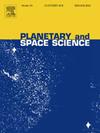土卫二冰类似物的水基离子辐射研究:辐射分解能解释南极羽流内部和周围的物质吗?
IF 1.7
4区 物理与天体物理
Q3 ASTRONOMY & ASTROPHYSICS
引用次数: 0
摘要
土星的磁层包含被捕获的等离子体和高能带电粒子,它们不断照射着土卫二的表面。在这项研究中,我们将土卫二表面含有H2O、CO2、CH4和NH3的类似冰暴露于能量在10到45 keV之间的水基离子(如O+、O3+、OH+和H2O+)中,目的是探索这些冰的化学演化,并表征土卫二表面物质被土星辐射环境风化的程度。利用傅里叶变换中红外透射吸收光谱对每个辐照过程进行现场监测,并对冰进行辐照后的加热,以更好地表征由于辐射分解产生的自由基的动员而形成的复杂有机分子。在所有的实验中,辐射都导致CO、OCN−和NH4+的形成,并且在大多数实验中也初步提出了甲酰胺、乙炔、乙醛和羟甲基自由基的辐射分解形成。辐照后的冰变暖导致氨基甲酸、氨基甲酸铵和一种醇的形成。虽然这些产物中的许多以前没有在土卫二表面观察到,但有些已经在土卫二的羽流中被检测到。由于我们的研究结果表明,这些分子的辐射分解形成可能发生在与羽流和表面物质暴露于磁层辐射的时间尺度相似的时间尺度上,因此必须提出这样的问题,即这些物质是直接来自地下海洋还是在富含辐射的空间环境中形成的。本文章由计算机程序翻译,如有差异,请以英文原文为准。
Water-group ion irradiation studies of Enceladus ice analogues: Can radiolysis account for material in and around the south polar plume?
Saturn's magnetosphere contains trapped plasma and energetic charged particles which constantly irradiate the surface of Enceladus. In this study, we exposed Enceladean surface ice analogues containing H2O, CO2, CH4, and NH3 to water-group ions (e.g., O+, O3+, OH+, and H2O+) having energies between 10 and 45 keV with the aim of exploring the chemical evolution of these ices and characterising the extent to which the surface material on Enceladus is weathered by Saturn's radiation environment. Each irradiation process was monitored in situ using Fourier-transform mid-infrared transmission absorption spectroscopy, and post-irradiative warming of the ices was performed to better characterise complex organic molecules formed as a result of the mobilisation of radiolytically generated radicals. Irradiation resulted in the formation of CO, OCN−, and NH4+ in all experiments, and the radiolytic formation of formamide, acetylene, acetaldehyde, and hydroxymethyl radicals was also tentatively suggested in most experiments. Post-irradiative warming of the ices resulted in the formation of carbamic acid, ammonium carbamate, and an alcohol species. Although many of these products have not been previously observed on Enceladus' surface, some have been detected in Enceladus' plumes. Since our results demonstrate that the radiolytic formation of these molecules can occur over timescales similar to the exposure times of plume and surface material to magnetospheric radiation, questions must be raised as to whether such material originates directly from the subsurface ocean or is instead formed within the radiation-rich space environment.
求助全文
通过发布文献求助,成功后即可免费获取论文全文。
去求助
来源期刊

Planetary and Space Science
地学天文-天文与天体物理
CiteScore
5.40
自引率
4.20%
发文量
126
审稿时长
15 weeks
期刊介绍:
Planetary and Space Science publishes original articles as well as short communications (letters). Ground-based and space-borne instrumentation and laboratory simulation of solar system processes are included. The following fields of planetary and solar system research are covered:
• Celestial mechanics, including dynamical evolution of the solar system, gravitational captures and resonances, relativistic effects, tracking and dynamics
• Cosmochemistry and origin, including all aspects of the formation and initial physical and chemical evolution of the solar system
• Terrestrial planets and satellites, including the physics of the interiors, geology and morphology of the surfaces, tectonics, mineralogy and dating
• Outer planets and satellites, including formation and evolution, remote sensing at all wavelengths and in situ measurements
• Planetary atmospheres, including formation and evolution, circulation and meteorology, boundary layers, remote sensing and laboratory simulation
• Planetary magnetospheres and ionospheres, including origin of magnetic fields, magnetospheric plasma and radiation belts, and their interaction with the sun, the solar wind and satellites
• Small bodies, dust and rings, including asteroids, comets and zodiacal light and their interaction with the solar radiation and the solar wind
• Exobiology, including origin of life, detection of planetary ecosystems and pre-biological phenomena in the solar system and laboratory simulations
• Extrasolar systems, including the detection and/or the detectability of exoplanets and planetary systems, their formation and evolution, the physical and chemical properties of the exoplanets
• History of planetary and space research
 求助内容:
求助内容: 应助结果提醒方式:
应助结果提醒方式:


